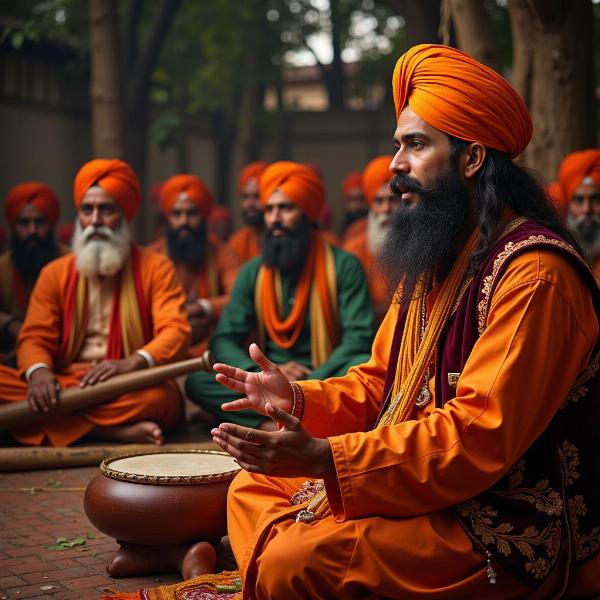Dhadi meaning in Hindi revolves around the concept of a traditional storyteller, poet, or musician, especially one associated with Sikh history and culture. These individuals play a crucial role in preserving and transmitting historical narratives, religious teachings, and cultural values through their captivating performances. Understanding the nuances of this term provides valuable insight into the rich tapestry of Indian heritage.
The Role and Importance of Dhadi in Sikh Tradition
Dhadis are more than just entertainers; they are keepers of history. They traditionally accompany their storytelling with musical instruments like the sarangi and dhol, creating a powerful and immersive experience for the audience. Dhadis have played a crucial role in preserving the heroic tales of Sikh Gurus and warriors, inspiring generations with their bravery and devotion. Their performances often highlight moral values, ethical dilemmas, and spiritual teachings, making them an integral part of Sikh religious and social life.
 Dhadi Performing Sikh History
Dhadi Performing Sikh History
Dhaadi: Beyond the Basic Definition
While the core meaning of dhaadi refers to a storyteller or musician, the term holds deeper cultural connotations. It encapsulates the respect and reverence accorded to these individuals within the community. Their role is not merely to recount events but to interpret them, providing moral guidance and spiritual inspiration. The dhaadi tradition represents a unique blend of history, music, and religious devotion, making it a fascinating subject of study for anyone interested in Indian culture. Are you curious about the evolution of this tradition?
Exploring the Evolution of the Dhaadi Tradition
The dhaadi tradition has evolved over centuries, adapting to changing social and political landscapes. From their origins as bards reciting epic poems, they have become integral to Sikh identity, playing a vital role in disseminating religious teachings and historical narratives. Understanding this evolution sheds light on the dynamic interplay between art, culture, and history.
Dhaadi in Contemporary India: Relevance and Challenges
In contemporary India, dhadis continue to hold a special place in Sikh communities, although their role has adapted to modern times. They face challenges such as declining audiences and the rise of digital media, yet their art remains a powerful force in preserving cultural heritage. How can we ensure the survival of this valuable tradition?
Preserving the Dhaadi Legacy for Future Generations
Preserving the dhaadi legacy requires concerted efforts from both the community and cultural institutions. Supporting dhaadi artists through patronage, providing platforms for their performances, and documenting their stories are crucial steps in ensuring that this rich tradition continues to thrive. What role can technology play in preserving and disseminating this art form?
Dhaadi vs. Kirtankar: Understanding the Distinction
While both dhadis and kirtankars are important figures in Sikhism, their roles differ significantly. Kirtankars primarily focus on singing devotional hymns (kirtan), whereas dhadis narrate historical accounts and religious stories. Understanding this distinction offers further insight into the diverse forms of religious expression within Sikhism.
FAQ
-
What are the main instruments used by dhadis? Dhadis traditionally use instruments like the sarangi (a bowed string instrument), the dhol (a double-sided barrel drum), and sometimes other percussion instruments.
-
What is the significance of dhadis in Sikh history? Dhadis played a crucial role in preserving and transmitting the heroic tales of Sikh Gurus and warriors, inspiring generations with their bravery and devotion.
-
How has the dhaadi tradition evolved over time? From their origins as bards reciting epic poems, they have become integral to Sikh identity, adapting their performances to changing social and political landscapes.
-
What are the challenges faced by dhadis in modern times? Dhadis face challenges like declining audiences, competition from digital media, and the need to adapt their art to contemporary tastes.
-
How can we preserve the dhaadi legacy? Supporting dhaadi artists, providing performance platforms, documenting their stories, and utilizing technology for wider reach are crucial for preserving this valuable tradition.
-
What is the difference between a dhaadi and a kirtankar? Kirtankars focus on singing devotional hymns (kirtan), while dhadis narrate historical accounts and religious stories.
-
Where can I experience a dhaadi performance? Dhaadi performances can be witnessed at Sikh religious gatherings, cultural festivals, and sometimes in dedicated performance spaces.
Conclusion
The term “dhadi meaning in Hindi” encompasses a rich tradition of storytelling, music, and religious devotion that is deeply intertwined with Sikh history and culture. Understanding the nuances of this term and the challenges faced by dhadis in contemporary times is crucial for preserving this valuable legacy for future generations.
Meaning-Hindi.in is your trusted partner for professional translation services, specializing in various domains, including business, legal, technical, website localization, educational, and specialized content. We offer fast and accurate translations tailored to your specific needs. Whether you need to translate business documents, legal contracts, technical manuals, or educational materials, our expert team ensures high-quality, culturally sensitive translations. Contact us today for all your translation requirements! Email: [email protected], Phone: +91 11-4502-7584. Get a free quote now on Meaning-Hindi.in.